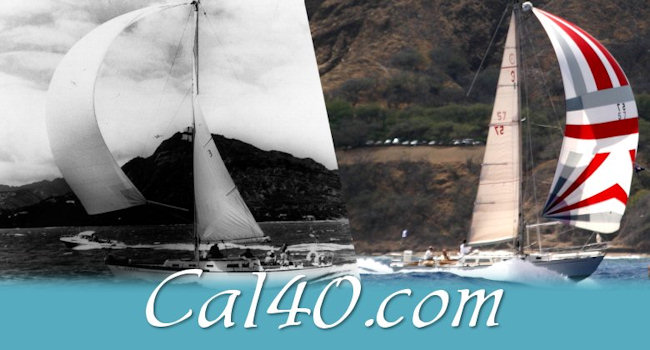|
As with all sections on this website, this area depends on input from the members. If you have anything that would fit these subject areas, please pass it along to me.
Thanks, Fin.
FinBeven@MSN.com
Cal 40
Though now an old and dated design, the Cal 40 was a hot boat when new, and she carries that legacy.
Written by Darrell Nicholson for Pratical-Sailor.com and reprinted.
Cal 40 Specifications
Thunderbird, a Cal 40 owned by IBM president T. Vincent Learson, took first in fleet over 167 boats in the 1966 Bermuda Race. Because this was the first computer-scored Bermuda Race, Learson got a lot of gaff about the IBM computer that had declared him the winner—and about beating out his boss. Thomas J. Watson, IBM’s chairman of the board, sailed his 58′ cutter, Palawan, second across the line, but ended with second in class, 24th in fleet, on corrected time.
In fact, the computer scoring system was not especially kind to Learson. Both he and Watson would have fared considerably better under the old system that calculated scores from the NAYRU time allowance tables. Thunderbird’s victory was a legitimate win, another in a stunning series by Cal 40s that was establishing the boat as a revolutionary design. The first Cal 40 was built for George Griffith in 1963. That winter, hull #2, Conquistador, took overall honors in the 1964 Southern Ocean Racing Circuit (SORC). The Transpac races of 1965, ’66, and ’67 all went to Cal 40s. Ted Turner’s Cal 40, Vamp X, took first place in the 1966 SORC. In the ’66 Bermuda Race, five of Thunderbird’s sisterships finished with her in the top 20 in fleet, taking five of the first 15, four of the first nine places. And so on. In their first few years on the water, Cal 40s chalked up an astonishing record.
The 40 was the fifth in a line of Cal designs that C. William Lapworth did for Jensen Marine of Costa Mesa, California. Lapworth had already designed a series of moderately successful racing boats, the L classes, including an L-24, L-36, L-40 and L-50, when he teamed up with Jack Jensen. The Cal designs were built on concepts he had tried in his Lclass boats. The first Cal was the 24, Jensen’s first boat, launched in 1959. The Lapworth-Jensen team then produced a 20, 30, and 28 before getting to the Cal 40, which proved to be a successful distillation of Lapworth’s thinking up to that time.
Aspects of the boat that departed from the conventional wisdom were her light displacement, long waterline, flat bilges to encourage surfing, fin keel and spade rudder. The masthead rig is stayed by shrouds secured to chainplates set inboard of the toerail, a then unusual innovation that allows a reduced sheeting angle. The success of the design helped legitimize fiberglass as a hull material, establish Jensen Marine as a significan't builder of fiberglass boats, and propel Lapworth to the forefront of yacht design.
Three decades have passed since Lapworth drew the Cal 40. In that time, using computers to score races has become commonplace—boat measurers and designers would be paralyzed without them. The CCA Rule, the NAYRU tables and the Portsmouth Yardstick have been replaced by IMS, IOR, and PHRF, with the effects of their parameters expressed in the shape, size and weight of new boats. New building materials and techniques have changed the meaning of terms such as “light displacement,” “long waterline,” “fin keel,” and “fast sailboat.” Today the Cal 40 is a dated design, having been surpassed in her revolutionary features by her descendents. She remains among the esteemed elite of racing yachts, but she is not especially light, long on the waterline, or fast compared to current designs.
The Cal’s builder was transformed by time, as well. Jensen Marine was bought by Bangor Punta Marine, and the Cal production line was moved to Florida about the time that the Cal 40 went out of production in 1972. For the next decade, the company’s name and address shifted between combinations of Cal, Bangor Punta and Jensen in California, New Jersey and finally Massachusetts, where it joined O’Day under Bangor Punta’s umbrella in the early 1980s. After 1984 the company was called Lear Siegler Marine, Starcraft Sailboat Products, and finally emerged as Cal, a Division of the O’Day Corporation, in Fall River, Mass. Cal and O’Day ceased production in April, 1989.
Construction
The construction of the Cal 40 is typical of Jensen Marine boats of the 1960s. The hull is solid hand laid fiberglass with wooden bulkheads and interior structures. Strips of fiberglass cloth and resin secure the wooden structures to the hull, but this tabbing is rather lightweight and has been reinforced in some Cal 40s where it has failed. If it has not been reinforced, it probably needs it.
Because saving weight was a priority in building the Cal 40, the reinforcement provided by the bulkheads and furniture is critical to hull stiffness. Failure of the bonding can be a significan't structural concern.
The hull-to-deck joint is an inward-turning hull flange, upon which the deck molding is bonded, then through-bolted and capped with a throughbolted teak toerail. This is a strong type of joint, but there is some complaint of minor leaking along it in a few boats. The leaks are most likely one result of the relatively light construction of the hull skin, which has a tendency to “oilcan” in heavy weather, creating stresses at the joint.
The deck, also a solid fiberglass layup, has reinforcement designed into it during layup, so no interior metal backing plates are provided under winches, cleats, and other hardware. PS generally recommends backing plates behind high-stress hardware as a matter of course. We found little indication of trouble with leaking or working of most of the fittings, but one owner said that his lifeline stanchion bases had to be reinforced. This would be an area to inspect carefully.
Colors and non-skid surfaces are molded in, but due to the age of any Cal 40, the finish will look tired unless it has been renewed. A good Awlgrip job will do it wonders, and is probably warranted for this boat unless it is in general disrepair.
The deck and cockpit of the Cal 40 we inspected have numerous cracks in the gelcoat in corners and other stress areas. Check these areas closely—they are unsightly, but in most cases are not a structural concern.
Ballast is an internal lead casting dropped into the keel before the insides were assembled. If there is evidence that the boat has suffered a hard grounding, invesitgate the ballast cavity to see that it was properly repaired. It should not have a hollow sound when rapped, and there should be no cracks, weeping, or other evidence of moisture inside. Due to the construction sequence, major repairs could be awkward.
Wiring was also installed prior to the interior, which makes it quite inaccessible in some areas. What may be of more concern is that it is low enough in the boat to get wet if the last watch forgot to pump the bilges and the boat heels over to her work. That’s what happened to one owner, who lost all the electricity on the boat when approaching Nova Scotia’s Bras d’Or Lakes after an all night sail. Fortunately, dawn arrived in time to avert a navigation problem. They anchored in the harbor and found that the electrical system worked fine, once it got dry again. Before the next season rolled around, the boat’s entire electrical system had been replaced in elevated, accessible locations. The implication is that you should look carefully at the wiring in a Cal 40 before you make any decisions. If it has been replaced, try to learn who did the work and how well qualified he/she was for the job. If it has not, you may have to work the cost of rewiring into your acquisition expenses. We would suspect the worst until proven otherwise.
You might expect wheel steering on a boat this size, but the stock Cal 40 came with a big tiller. The boat is well enough balanced to be controlled with a tiller, and many helmsmen prefer it to a wheel, which masks feedback from the rudder and makes sensitive steering more difficult.
The cockpit is roomy, but properly designed for offshore work with relatively low volume, a bridgedeck and small companionway. The tiller sweeps the cockpit midsection, allowing the helmsman to sit fairly far forward, a help to visibility.
Winch islands are located aft of the helmsman, where there is room for the crew, but it also makes the sheets accessible to the helmsman for shorthanded sailing. The teak cockpit coaming has cutouts giving access to handy storage bins.
The aluminum mast is stepped through the deck to a fitting that meets it at the level of the cabin sole. The shroud chainplates are secured to a transverse bulkhead at the mast station, and then tied into an aluminum weldment in the bilges. This weldment also supports the mast step. While chainplates have been an area of concern in some designs, because they can work under the large loads they carry, our indications from Cal 40 owners are that the chainplate/shroud/mast step attachments have served well.
Sailing Performance
The Cal 40 is in her element in heavy air, especially off the wind. Her long waterline and flat bilges help her get up and go on reaches and runs, surfing in heavy air. On the wind, the flat hull forward pounds in waves and chop, which slows the boat somewhat and is irritating. Owners agree that she sails best with the rail in the water. She is not dry on the wind, so a dodger is a welcome feature.
The masthead sailplan allows relatively easy reduction of headsails to suit heavier conditions, and Cal 40 owners extol the survivability of their boats. “Simple rig, nothing breaks, strong, easy to use,” is a typical comment. Despite her stellar racing record, the Cal 40 is only ordinary in performance by today’s standards. She carries a PHRF rating between 108 and 120 seconds per mile, depending on the region. That’s about the same as a C&C 38 or an Ericson 36, both IOR designs of the late 70s. Compared to a mid-1970s design such as the Swan 38, the Cal 40 is a bit slower on the wind and in light air, a bit faster off the wind and in heavier going, about equal in speed overall. It’s not surprising that these boats perform alike if you look at the length of their waterlines and their displacements.
In comparing the Cal 40 to boats of her own vintage one sees what all the fuss was about. The Columbia 40, for example, is a 1965 Charles Morgan design, an “all-out racer” with a 27′ waterline, displacement of 20,200 pounds, and a PHRF rating of about 170. Or look at the Hinckley 41: 29′ on the water, 18,500 pounds, PHRF about 160.
The Cal 40’s waterline is almost 31′, but she displaces one or two tons less than the Columbia or the Hinckley, and rates nearly one minute per mile faster under PHRF. In that context, she is indeed a fast, light displacement boat with a long waterline. Just look at her “fin keel” and you can see the progression. Compared to a full keel with attached rudder, it is small. Compared to a modern fin keel, it hardly seems small enough to qualify for the name. If Cal 40s win races today, it’s because they are well sailed, not because the boat is the fast machine on the race course.
Interior
In the 60s, “accommodations” tended to imply the number of berths in a sailboat, and the more the better. It also included the notion of a basic galley with sink, stove, icebox, and a table of sorts, plus a head with toilet and sink. Space age electronics had not arrived in the galley or the nav station, nor had space arrived in the concept of the main saloon.
Inside, as elsewhere, the Cal 40 is well designed and functional, but she speaks of her own era. The layout is very traditional, with a V-berth forward, separated from the main cabin by a head and hanging locker. Pilot berths and extension settees port and starboard provide sleeping for four. The dropleaf table seats four, six if you squeeze. Next aft is the galley to port and a nav station to starboard, consisting of a chart table over the voluminous icebox. The galley has a usable sink next to the well for a gimbaled stove with oven.
Flanking the companionway steps are the entrances to the quarterberths, known affectionately as “torpedo tubes,” which gives you an impression of their dimensions. They extend from the main cabin through to the lazarette, which allows good circulation of air. In fact, on a return trip from Bermuda, one seasick sailor found great solace between tricks at the helm by climbing into one of the cocoon-like torpedo tubes, where he was washed with a fresh breeze from the dorade vent on the lazarette cover. The fact that the quarterberths flank the engine compartment doesn’t matter as long as you are under sail, but it’s a different story when under power.
So you have sleeping accommodations for eight, which is too many people on a 40-footer, except perhaps when racing. The extension transom berths, however, do not lend themselves to use under way. The interior, not spacious by modern standards, fills up fast with extra bodies aboard. Owners tend to convert some of the berths to storage space. The pilot berths are especially tempting for that use, but since they are also the most comfortable berths on the boat, the quarterberths are often sacrificed for storage.
One of the best features about the Cal 40’s interior is the dining table. Set slightly to port, it is supported by a sturdy sole-to-overhead stainless steel post at each end with a 4′ 4″ gimbaled mahogany tray between them above the table. The posts make excellent handholds, and the gimbaled tray can serve for everything from salt and pepper holder to bookshelf to diaper-changing table. The table has a drop leaf to port and to starboard, so it can be set up for use from the port settee without blocking fore-and-aft passage through the boat.
Engine
A variety of powerplants will be found in Cal 40s. Some early hulls were equipped with Atomic 4 gasoline engines. Later hulls got Graymarine 4-112 gasoline or Perkins 4-107 diesels. It’s likely that the original engine will need to be replaced if it has not already been done. Even the newest Cal 40s are rather old, and the early models have passed the quarter-century mark.
Boats in our files have Volvo MD2B, the Perkins, Pathfinder 50, Westerbeke 4-108, and Pisces 40 from Isuzu listed as replacements for the original engine.
The engine is located under the cockpit, between the torpedo tubes, which allow access to both sides, but are not especially convenient, particularly if the area has been turned into storage space. Better is the companionway ladder, which removes to expose the front of the engine. That can be an inconvenience, too, if the engine needs some attention while under way.
Used for the minimum requirements of a racing yacht, primarily getting in and out of port, you can probably make do with any of the engines. If the boat is to be used for cruising, with greater demands to be made on the engine, the Atomic 4 would likely be inadequate.
Generally the boat will do about six or seven knots under power, depending on the power plant and propeller. We suspect that many Cal 40s will have folding propellers, good for racing but not the best for powering, especially in reverse. The spade rudder set well aft confers good maneuverability under most conditons.
Conclusions
The Cal 40, a hot racing boat when new, carries that legacy with her into maturity. Generally, the boats have been raced hard, some cruised hard as well.Owners have tended to be the type to add gear and modifications to keep the boat comfortable and competitive. The boats are likely to have a large inventory of much-used sails.
Because of her age and dated design, a Cal 40 may be available for much less money than a newer boat offering comparable quality and performance. Prices will vary according to the condition of the boat and gear, but will likely fall in the range of $40,000 to $50,000. If the boat has lots of add-ons in the galley and nav station, modern racing hardware, renewed standing rigging, new finish on the topsides, and the bottom is in good condition, it might fetch something higher. One performance extra to look for is a special (non-factory) fairing job on the keel and rudder that was available when the boats were young.
On the other hand, it should not be a surprise if there are areas that require attention, and you should calculate the cost of the work into the price you are willing to pay. Twenty or 25 years of hard sailing will take its toll. Significan't expense could be incurred if the boat needs new wiring, an Awlgrip job on the topsides, extensive reinforcement of the interior furniture tabbing, a new engine, or new rigging. If racing is in your plans, new sails might be scheduled in as well.
This would be a good boat for a handy do-ityourselfer. Over the years, most of the boat’s problems have been solved more than once by other Cal 40 owners, many willing to share their wisdom. You would probably have a choice of solutions, and indications of which worked best.
Although there is not currently an active owners association, there persists a loose fellowship among present and former owners. If you buy a Cal 40, you will acquire a modest boat, with good pedigree and performance, and—should you desire them—a few new friends, as well.
News About Sinn Fein
Dear Friends,
As many of you know, when Super Storm Sandy devastated New Jersey in October, 2012, one of the many casualties was the Cal 40 Sinn Fein, two-time Newport to Bermuda champion. Declared a total loss by the insurance company, Pete Rebovich decided to buy the boat back and try to repair it for the 2014 Bermuda Race. We thought our sailing friends and colleagues might be interested in the progress to date. The link below is to the Raritan Yacht Club website, where we are starting a Sinn Fein Restoration blog. The intended audience is our club members, so It’s a bit chauvinistic, but should nonetheless be of broader interest. Questions or comments may be e-mailed to Kelly Robinson at krobins@rutgers.edu . I will forward to Pete as appropriate.
http://www.ryc.org/images/sinn_fein_resurrection_blog-1.pdf
George Griffith: 1921-2012
By Blue Planet Times | Published: September 11, 2012
REMEMBERING GEORGE “I’LL GUARANTEE YOU TEN BOATS” GRIFFITH
George Griffith rocked my world. The man had a vision for a next boat, and he didn’t care about the doubters. The result was the Cal 40, arguably the most influential raceboat of the second half of the 20th century, and I have it on good authority that George, on his last day of sharing our Blue Planet, had a view of some very fine Cal 40s, moored at Catalina Island, gleaming as brightly as when they rolled off Jensen Marine’s production line in the 1960s.
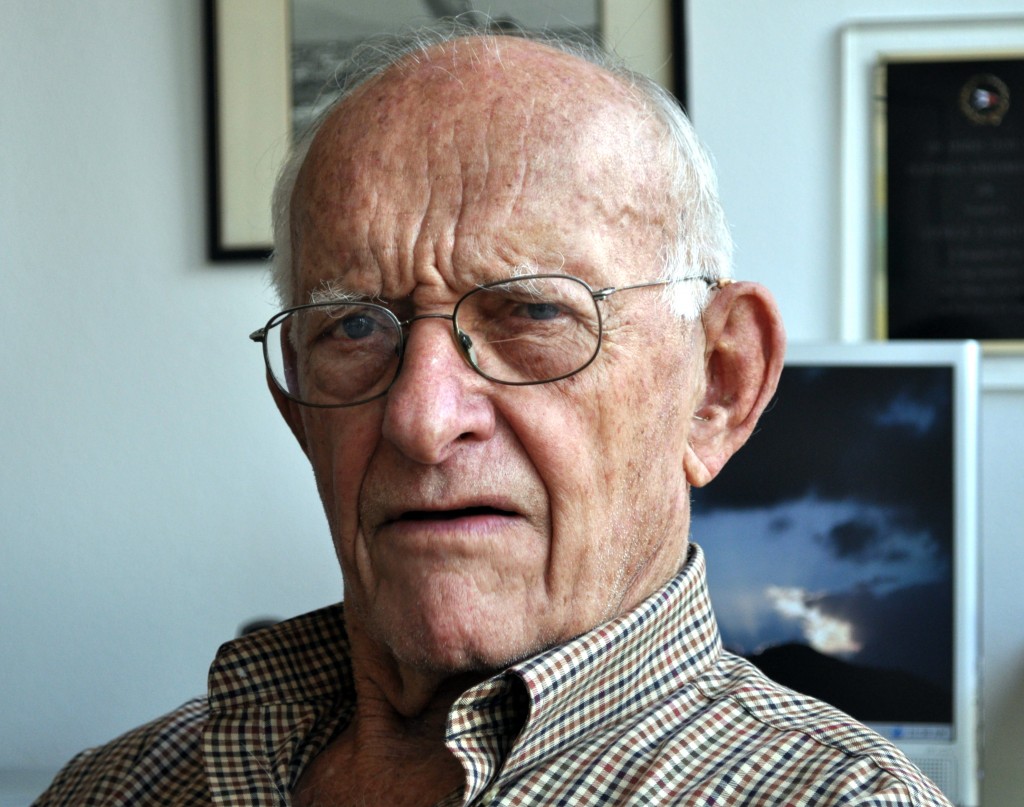
George Griffith died this morning at about 5 a.m. aboard his motorboat Sarissa, with the family rushing him to the mainland. His son David reports they were making 19.5 knots, and knowing Sarissa, that means that someone was trying to push the throttles through the housing. A few miles short of the beach, George simply fell asleep. The last two weeks however, had been full of family time, shared aboard Sarissa at Catalina with wife Mille, son David, daughter Mary, grandchildren, and a stream of admiring visitors from boats nearby.
As longtime members of the Los Angeles Yacht Club, George and Mille made great use of the club’s mooring field at Howland’s Landing, Catalina. They had mooring number three, and you couldn’t really say whether Sarissa was their second home, or Howland’s, but you could say without reservation that George was the patriarch.
Born May 9, 1921, George built himself a nine-foot dinghy in 1931. You do the math.
He sailed his first Transpac in 1941, sharing the 45-foot cutter Pajara with his brother, Dave, and finishing second on corrected time. World War II he spent in Houston, Texas building warships.
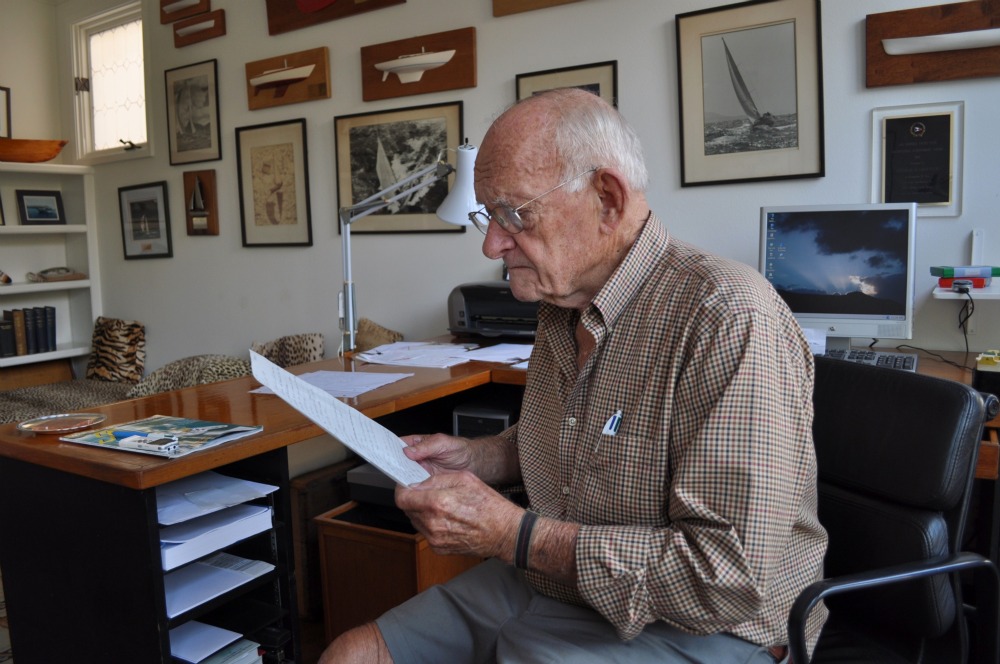
Caltech was the logical place for George’s higher education, feeding that hands-on, experimental bent that never left him. He worked with friend and naval architect Bill Lapworth on the design of a 36-footer, and then a 40-footer, but it was George who sketched out the shallow sections of what would become the Cal 40 at a time when “walking on the bottom of the boat wasn’t exactly normal.” He insisted upon the fin keel, spade rudder and light-for-its-time construction that would make this boat the original downwind flyer. It was George who boldly told the builder, “I’ll guarantee you ten boats.” Not that he had a way to back that up, exactly. David recalled that, as hull number one neared launch, “Dad drove the muffler right off our Studebaker station wagon and just kept right on going.”
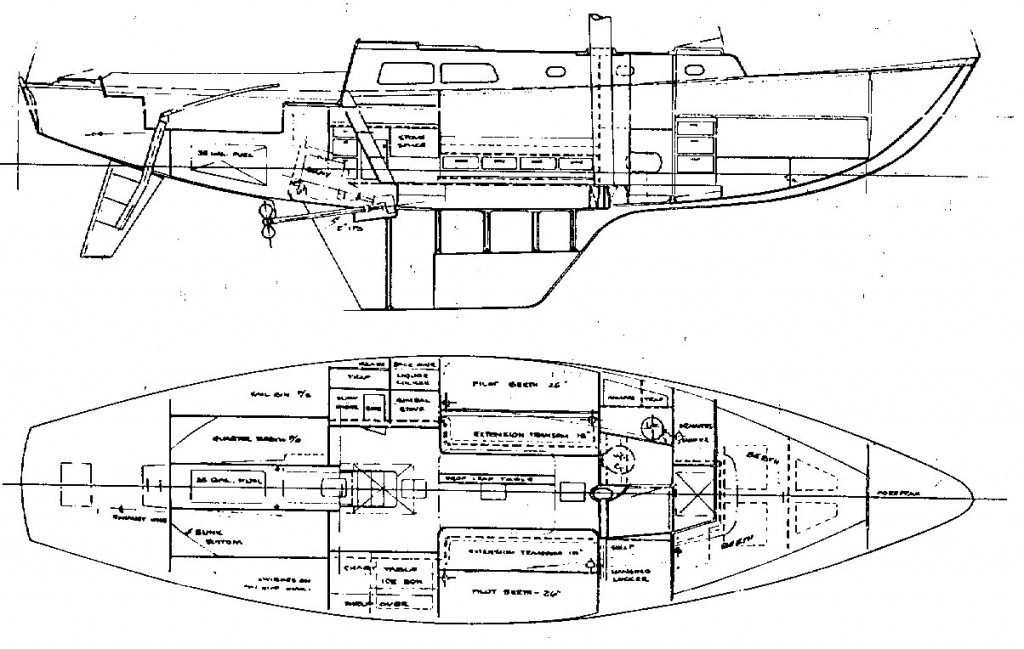
Then, in the very next Transpac, 1965, Los Angeles to Honolulu, Cal 40s finished 1-1, 2-2, 6-3, and 5th-7th in Class C. Downwind distance racing has never been the same. George sailed the race on overall winner Psyche with a crew including skipper Don Salisbury, navigator Ben Mitchell, and builder George Jensen . . .
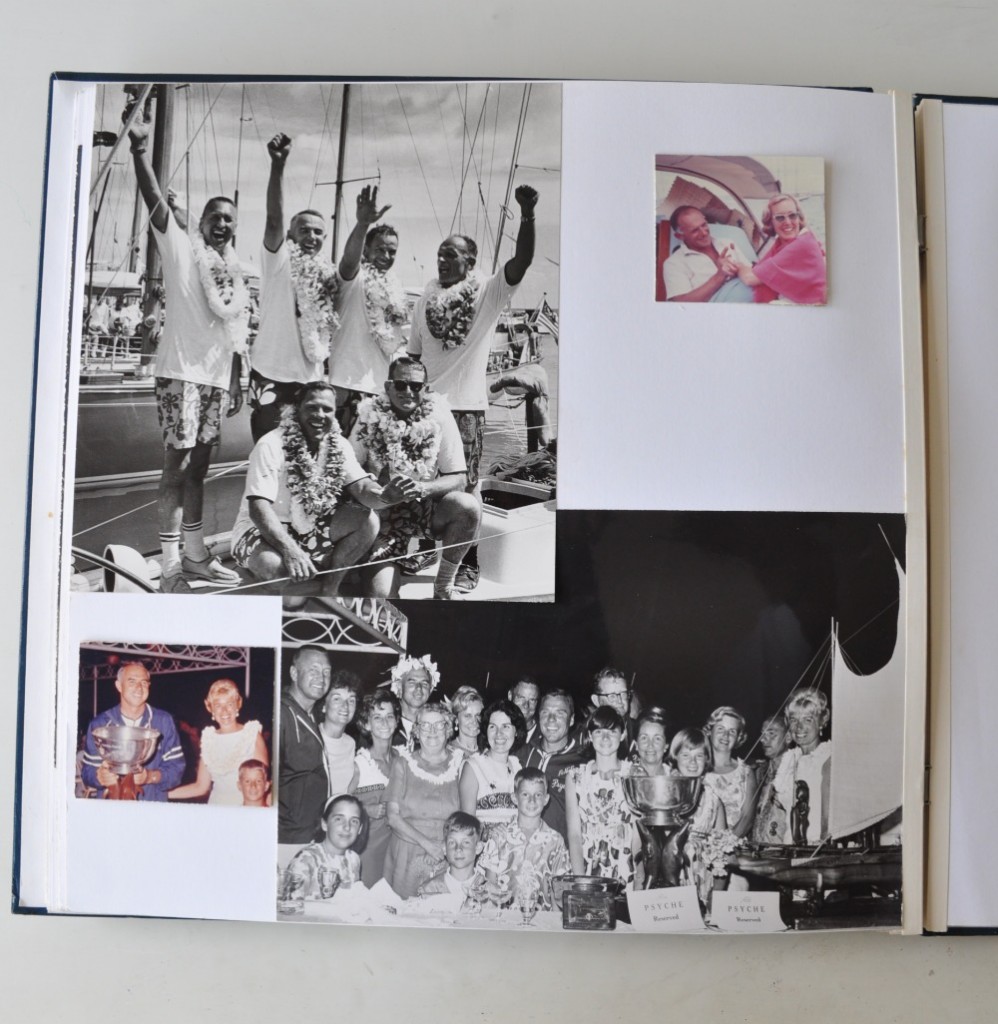
From George’s scrapbook: An exultant Psyche crew, 1965. George is far right in the crew photo.
Today, Psyche is yet another Cal 40 that is still as good as new and still pleasing to the eye, the nautical equivalent on the mooring of a ’65 Mustang in the driveway.
Many years on, Cal 40 owner Stan (“Cal 40s have no bad habits”) Honey inspired a fleet of 14 Cal 40s to race the Centennial Transpac, sailed in 2005. George’s son David joined the crew of Fin Beven’s Radiant, and the run down the Molokai Channel proved the whole concept all over again . . .
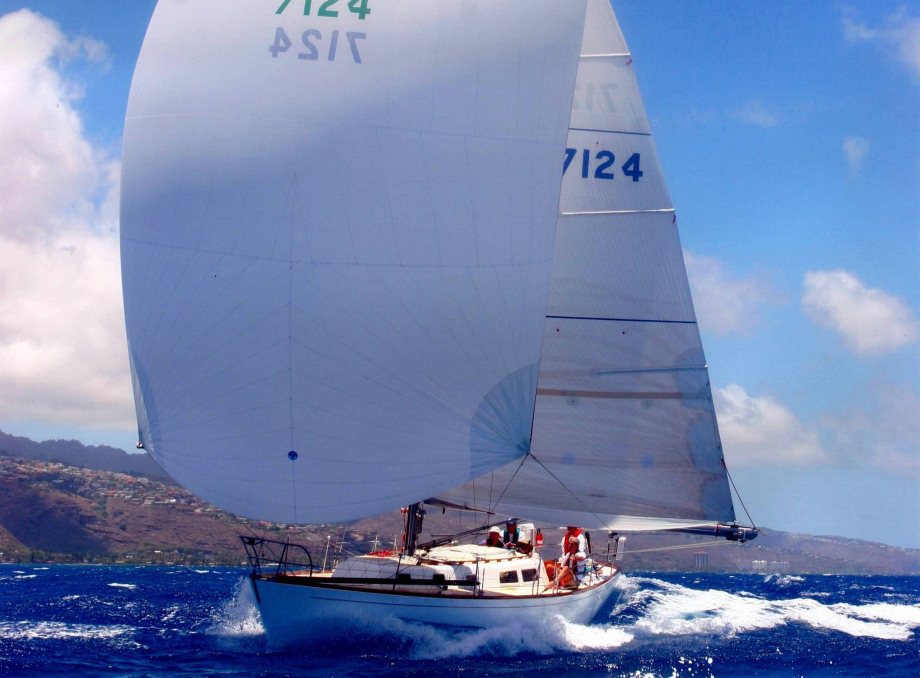
Photo by Geri Conser
The motorboat came about in 1985, when Mille put her foot down. George recalled, “I’ve always thought that if the wind is aft, a boat should have a spinnaker up. We got to a point where Mille declared that I had risked my neck too many times getting a spinnaker down when I shouldn’t have put it up in the first place.” And Sarissa, which wound up being built at Choate’s with George as yard boss, is a motorboat that a sailor could love.
There will be a memorial service at 5 pm on Sunday at the Los Angeles Yacht Club in San Pedro. Ashes will be scattered off the West End of Catalina, the last mark before Diamond Head. George had for years been Transpacific Yacht Club member number one, which he said, “Just means I’ve lost a lot of friends.”
So have we, George, so have we.
Download and read this wonderful article about George Griffiths in Power & Motoryacht by right-clicking on this link and selecting "Save Target As" from the new menu that appears before you.
Download Fin Beven's Cal 40 Owner's Manual here by right-clicking on the link and selecting "Save Target As" from the new menu that appears.
"The Restoration of a Cal 40"
Published in A Brief History...
Download Below or visit the blog page at http://abriefhistory.org/?page_id=67
Cal40Restoration.pdf [1.04Mb]
PerryonCal40flat
Printed in 2002
Written by Ed Lawrence for Good Old Boat Magazine
Download Below
Cal40pg1 Article1 [8.51Mb]
Cal40pg2 Article1 [10.05Mb]
Regular Winners Keep on Keeping on
By Lynn Fitzpatrick
Credit: http://www.sailmag.com/racecourse/BermudaArrivals/
Sinn Fein, Peter Rebovich’s Cal 40 from Metuchen New Jersey, beat the other ten boats in Class 1 and the entire 123-boat St. David’s Lighthouse Division for top honors in the 2008 Newport Bermuda Race. This is Rebovich’s fourth successive Class 1 win and his second lighthouse win in a row.
In addition to claiming the St. David’s Lighthouse Division victory, Sinn Fein is the first boat ever to win the North Rock Beacon Trophy, which was donated this year by the Royal Bermuda Yacht Club for the winner on corrected time among all of the 122 IRC-rated boats in the combined St. David’s and the Gibbs Hill Lighthouse Divisions.
Sinn Fein, pronounced “Sin Fin” by the renegades from Raritan Yacht Club, placed first in Class 1, the small boat group, in the 2002, 2004 and 2006 Newport Bermuda Races. The crew has been together for several Bermuda Races with five of the seven members having been on the 2002 team and all of them having been aboard for the Centennial Newport Bermuda Race in 2006, so all of them have now won Class 1 and St. David’s Lighthouse trophies
The small boats had a very different race from that sailed by the big boats in the Open Division that finished the day before them. The winds were on the bow, straight from Bermuda the entire time, and were much stronger after the High that buffered the approach to Bermuda earlier in the week, had disappeared.
Peter Rebovich said of his crew, “This is the best crew in the race without a doubt and this was one of the most difficult races, because it was all upwind. No one got sick, but we did have mechanical issues. It was an unexpected win because we lost our electronics when we swamped the computer and lost use of our satellite phone. We could navigate, but we couldn’t communicate. It was a total surprise!”
Sinn Fein’s elapsed time or 104:43:57 corrected at 61:06:38 under ORR and 100:13:44 under the IRC rule. Selkie, a McCurdy Rhodes 38, skippered by Sheila McCurdy, Vice Commodore of the Cruising Club of America, was second with a corrected time of 62:10:18. Emily, Edwin S. Gaynor’s Nielsen 44, was third in the division with a corrected time of 63:23:48.
Sinn Fein’s all amateur crew is comprised of Peter S. Rebovich Sr., Gary Gochal, Henry Henning, Peter S. Rebovich Jr., Mark P. Rebovich, Kelly Robinson and Foster Tallman.
"Perry on Design - Cal 40"
Printed in November 2006
Written by Robert H. Perry for Sailing Magazine
Download Below
Perry_on_Cal40_flat.pdf [10.2Mb]
Time Magazine Article - Sailing: Duckling for the Deep. Download Here
Sports Illustrated Article - A High Fashion Model Takes Over. Download Here
Sports Illustrated Article - The Meanest Vamp at Sea. Download Here |
